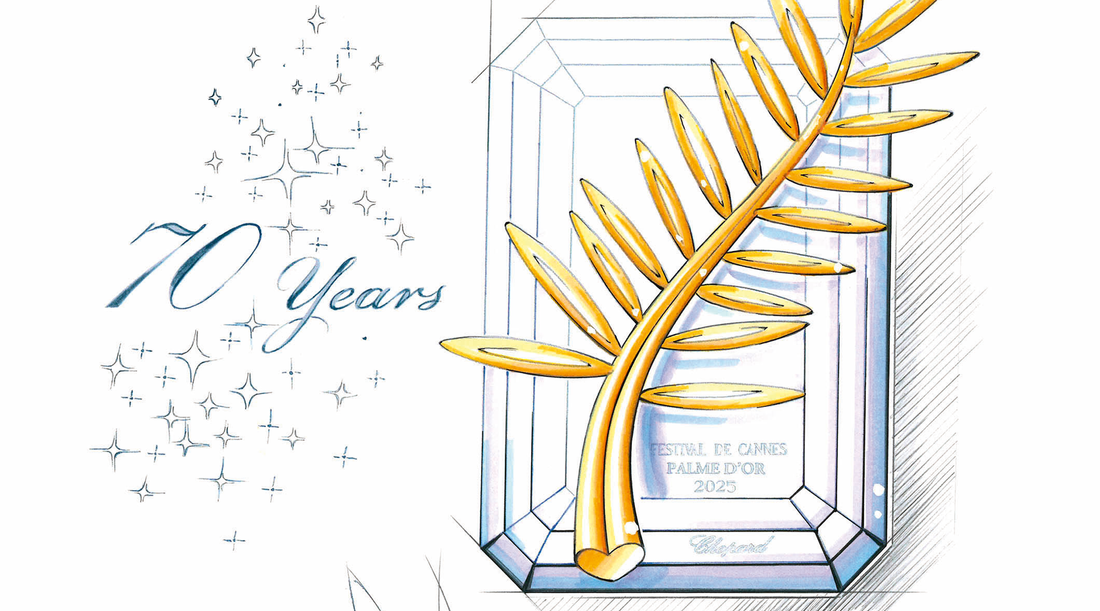
CHOPARD - Palme D'or celebrates 70 years
Share
Recognized as the highest honor in the seventh art, the Palme d'Or celebrates its 70th anniversary this year. The mere mention of its name brings to mind unforgettable memories of the silver screen, as well as Chopard's admiration for the Cannes Film Festival, of which it has been an official partner since 1998. The Cannes Film Festival closing ceremony is, in fact, the most publicized event on the planet, after the World Cup and the Olympics. Each Palme d'Or award is distinct and beautiful in its own right, having been the dream and the source of glamour for filmmakers for 70 years, although the award only took its current form in 1998, thanks to the creative audacity of Caroline Scheufele, Chopard's Artistic Director.

The Maison's privilege of designing and creating the Palme d'Or, as well as all of the Festival's awards, has a storied history. Between 1946 and 1954, the Festival's main trophy was called the Grand Prix du Festival International du Film and took the form of a work of art that was renewed for each edition. In 1954, a competition was launched among several jewelers to create a permanent and instantly recognizable award. Lucienne Lazon created the first trophy, inspired by the coat of arms of the city of Cannes and awarded to Delbert Mann by Marty in 1955. From 1964 to 1974, there was no Palme d'Or: the Festival temporarily returned to the Grand Prix before deciding to once again offer the famous award for best cinematographic work. In the early 1980s, the base of the Palme d'Or became pyramidal, and in 1992, jeweler Thierry de Bourqueney redesigned it and created its 19 leaflets, placed in a hand-carved crystal pyramid.

In 1997, when she met Pierre Viot, then President of the Cannes Film Festival, Caroline Scheufele was staring intently at the Palme d'Or displayed in his office: a palm leaf placed on an acrylic pyramid. When she explained that her profession was jewelry design, she was invited to redesign the Palme d'Or.

And when a love of cinema and a passion for fine jewelry merge, anything is possible. Consider the little heart—the House's symbol—that the Artistic Director reinvented at the tip of the Palme d'Or's stem. Overall, the designer completely revamped the trophy, modernizing it while remaining faithful to the famous palm trees that line the Croisette and the Cannes coat of arms. The "Holy Grail" of cinema gained prominence and depth, becoming a true piece of jewelry with its 19 18-karat yellow gold leaflets mounted on a hand-cut rock crystal cushion like a diamond. With the new Palme d'Or, Chopard became an official partner of the Cannes Film Festival in 1998.
As Caroline Scheufele once stated, "The Palme d'Or is not just a trophy; it represents a declaration of love for cinema." It takes no less than 70 hours of meticulous work to create the Palme d'Or. Since 2014, as part of Chopard's Journey to Sustainable Luxury, it has been crafted from ethical gold. Extracted according to the highest social and environmental standards, these 118 grams of gold pass through the hands of six specialized artisans. The numerous manufacturing steps include the mold produced using the "lost-wax casting" technique, or the melting of the metal at 900 degrees Celsius in the Chopard workshop foundry. The Palme d'Or is assembled with meticulous finishing of the leaflets and stem, and final polishing. The crystal is drilled with a diamond cutter to accommodate the small supports on which the Palme d'Or will rest, finally placed on the crystal cushion.

Since its creation in 1955, the Palme d'Or has become the most coveted award in the film industry, synonymous with excellence and recognition for filmmakers worldwide. Its history will continue to be written, with the luxurious stamp of Chopard, a true artisan of emotions.
Text: Carla Martins
Photos: Chopard
